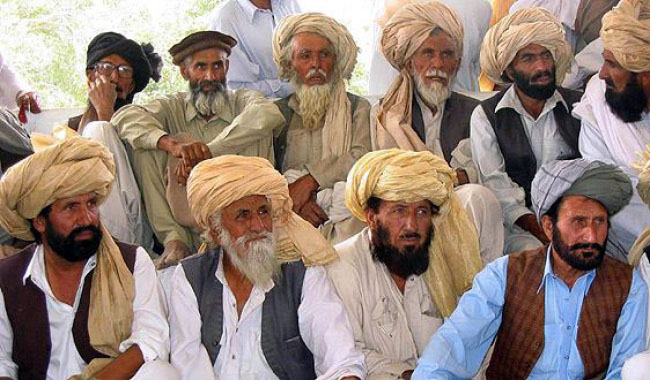Addressing a news conference in Kabul, Afghan former President Hamid Karzai said he had written a formal letter to President Ashraf Ghani, urging him to convene an emergency traditional grand assembly of elders (Loya Jirga) for discussing Trump’s war plan and finding a way out of the conflict. Whether or not Loya Jirga is conducted and regardless of the fact that officials urge for convening Loya Jirga every once in a while, this commentary will shortly views this National Assembly in accordance with Afghanistan’ Constitution.
In Afghanistan’s history, Jirgas (assemblies) mainly Loya Jirga played a crucial role in national affairs. Afghanistan’s past and present constitutions were endorsed by Loya Jirga and effective political decisions were also made by it.
To view the legitimacy and qualification of Loya Jirga for approving constitution from legal and Islamic viewpoint, there are three perspectives. The first argument is that the “Loya Jirga” is the “Constituent Assembly” which, in contemporary constitutional law, is considered as one of the democratic methods for approving constitution. The second is that Loya Jirga is Majlis-e-Hal wa Aqd (the council of great clergy – conducted after the demise of Holy Prophet for appointing the Caliph). The third argument is that Loya Jirga in Afghanistan is based on the rule of law. That is to say, it has been accepted in Afghanistan’s custom of constitutional law with the qualification of approving constitution.
It can be claimed that Loya Jirga was a complete and clear example of the custom of law in Afghanistan’s legal and political history. Nonetheless, the past regimes capitalized on it to gain legitimacy and achieved their ambitious objectives through conducting Loya Jirga. On the other hand, no standard and suitable criteria were considered for participating in National Assembly and mostly tribal elders, influential figures, and members of the government were elected to attend this assembly. This will naturally relegate the status of Loya Jirga as well as smooth the path for exploitation.
Considering this issue, traditional Loya Jirga was inserted in Afghanistan’s constitution during the regime of King Zahir Shah in 1343 (solar year). Since it was defined in the frame of law, there is no traditional Loya Jirga. Hence, in case of conducting traditional Loya Jirga rather than legal one, it will not be binding. Loya Jirga is supposed to be conducted with the ins and outs explained in the constitution. In Afghanistan’s present Constitution, certain criteria are deemed for conducting Loya Jirga. In addition to defining Loya Jirga as the highest manifestation of the will of the people of Afghanistan, the constitution specifies members of Loya Jirga in article 110 who are: (1) Members of the National Assembly. (2) Presidents of the provincial as well as district assemblies. (3) Ministers, Chief Justice and members of the Supreme Court as well as the attorney general shall participate in the Loya Jirga sessions without voting rights. The competencies of Loya Jirga is specified in article 111 as: (1) To decide on issues related to independence, national sovereignty, territorial integrity as well as supreme national interests. (2) Amend provisions of this Constitution. (3) Impeach the President in accordance with the provisions of Article 69 of the Constitution. The constitution adds that no member of the National Assembly shall be legally prosecuted for reasons of voting or views expressed during performance of duty. In short, the current constitution stipulates explicit and transparent mechanism for conducting the National Assembly so as to prevent from probable exploitations.
There still seems ambiguity regarding Loya Jirga. During Hamid Karzai’s administrations many Loya Jirgas were convened such as: Emergency Loya Jirga in 2002 to elect the head of the Transitional Government, the Loya Jirga for ratifying constitution in 2003, Regional Safety Jirga between Afghanistan and Pakistan in 2008, National Consultative Peace Jirga in 2010, and traditional Loya Jirga to discuss the strategic partnership with the United States and the issue of national reconciliation held in 2011.
The first and second aforementioned Loya Jirga was held after being approved in Bonn Conference, before the endorsement of constitution, for establishing transitional government. The third and fourth Jirga was simple Assembly (not Grand National Assembly) and both were consultative Jirga – which is not binding. But all controversy began with the traditional Loya Jirga held in 2011. Karzai again suggests holding traditional Loya Jirga and the past controversy resurfaced. The main reason behind this controversy is that whether traditional Loya Jirga is in accordance with constitution or not. Is it legitimate based on constitution?
All the ins and outs of Loya Jirga are explained in chapter 6 of the country’s Constitution, which was mentioned above. Loya Jirga is no more traditional in Afghanistan since it is inserted in the written law. In another item, traditional Loya Jirga has no legal basis. However, consultative Loya Jirga is neither binding nor illegal; that is, this Loya Jirga is similar to a “political summit” conducted for referendum and public suggestions rather than a legal Loya Jirga stated in Constitution. Karzai might remember when he opposed the suggestion for holding traditional Loya Jirga in the end of his first administration saying that it was against constitution. On the other hand, he conducted consultative Loya Jirga for signing security pact with the US during the last days of his second presidential period but refused the Jirga’s decision.
Home » Afghanistan » Traditional Loya Jirga – An Obsolete and Ineffectual Mechanism
Traditional Loya Jirga – An Obsolete and Ineffectual Mechanism

